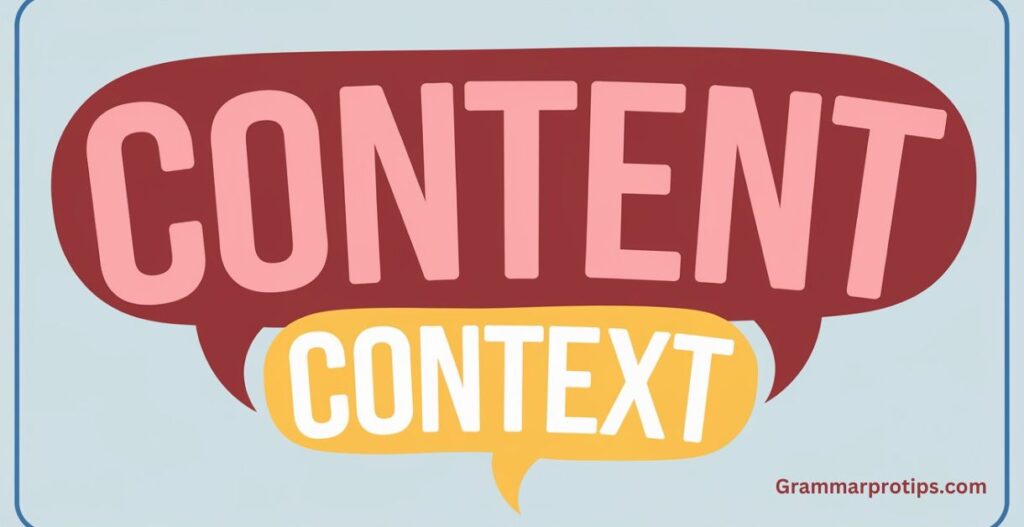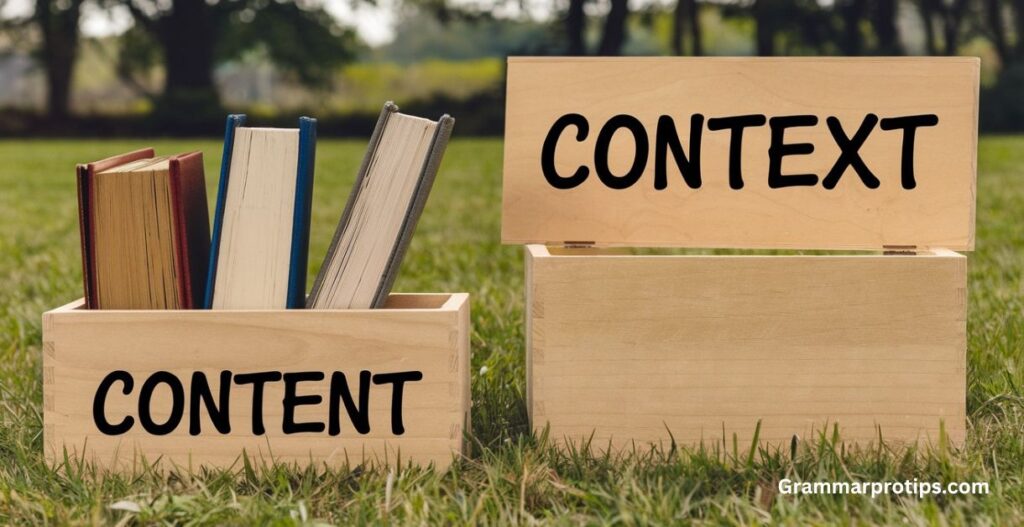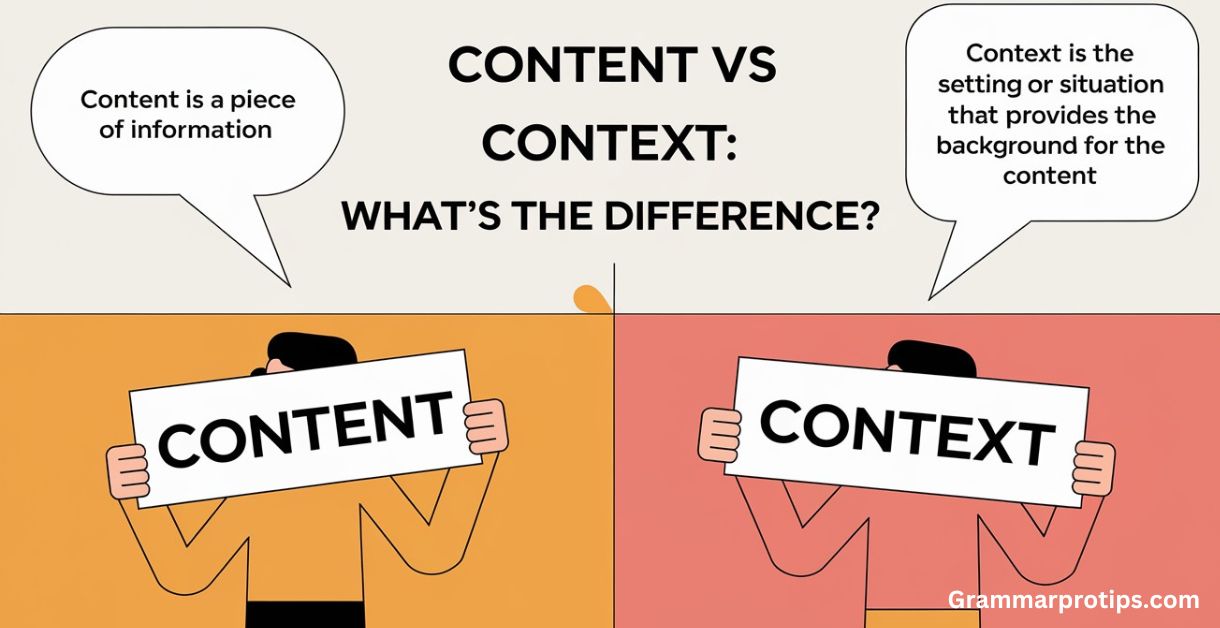When it comes to communication, two terms often come up: content and context. While they might sound similar, their roles in effective communication are vastly different. Grasping the content and context difference is essential for anyone looking to improve their ability to convey ideas clearly and avoid misunderstandings.
To put it simply, content refers to the actual information being shared words, images, data, or any other form of message. On the other hand, context encompasses the circumstances surrounding that message, including the environment, timing, tone, and even the relationship between the sender and the recipient. Together, these elements shape how a message is interpreted.
Defining Content: The Core of Communication
At its heart, content is the substance of any communication. It’s what fills the pages of books, populates websites, and drives conversations. Whether it’s written text, spoken words, or visual media, content serves as the vehicle through which information is delivered. However, without proper framing, even the most well-crafted content can fall flat.
Consider a professional email sent by Sarah to her colleague John. She writes:
“Hi John,
Please review the attached report and provide feedback by Friday.”
The email content here is straightforward—it includes a request, a deadline, and an attachment. Yet, if John doesn’t understand the urgency or importance of the task, he may not prioritize it correctly. This demonstrates how relying solely on content can lead to gaps in message clarity.
Why Content Alone Isn’t Enough

Content provides the raw material for information conveyance, but it lacks depth without additional layers. For instance, think about a social media post announcing a product launch. The caption reads: context vs content
“Our new gadget is finally here! Get yours now!”
While the content interpretation seems positive, potential customers might hesitate if they don’t know the price, availability, or unique features of the product. In this case, the absence of background information creates confusion rather than excitement.
This is where context steps in to bridge the gap.
Exploring Context: The Invisible Framework
If content is the “what” of communication, then context is the “why,” “when,” “where,” and “how.” It adds meaning to the message by considering factors like cultural norms, emotional states, and situational cues. Ignoring context in communication can result in a misunderstood statement or unintended consequences.
Let’s revisit Sarah’s email to John. Suppose she had added some clarification of message by saying:
“Hi John,
I’m preparing for the client meeting next week, so please review the attached report and provide feedback by Friday. Your input will help us finalize our strategy.”
Now, the circumstances influencing message are clear: Sarah needs John’s input because it directly impacts an upcoming event. By providing context, she ensures that John understands the significance of his role, leading to better collaboration.
Real-Life Scenarios Highlighting Context
Imagine receiving a text from a friend named Emily that says:
“I can’t believe you did that!”
Without context, this message could evoke panic. Did you offend her? Forget something important? But what if Emily follows up with:
“You surprised me with those concert tickets! Thank you so much!”
Suddenly, the initial alarm turns into gratitude. This shift illustrates how context transforms the way we perceive messages.
Another example involves workplace dynamics. Picture a team meeting where someone says, “This approach isn’t working.” Depending on the speaker’s tone, body language, and prior discussions, the same phrase could either signal constructive criticism or frustration. Recognizing the importance of context helps prevent message misunderstanding.
Content vs Context: A Comparative Analysis
To further clarify the difference of content and context, let’s break down their key characteristics in a table format:
| Aspect | Content | Context |
|---|---|---|
| Definition | The actual message being communicated | The setting, conditions, and background details |
| Focus | What is said or shown | Why, when, and how it is said or shown |
| Example in Email | Text, attachments, links | Timing, sender’s intent, recipient’s perspective |
| Impact on Interpretation | Provides facts and instructions | Shapes emotional response and overall meaning |
| Key Phrase Connection | Difference between content and context | Context vs content |
This comparison underscores the complementary nature of these concepts. While content delivers the core message, context ensures it lands effectively.
How Context Influences Content Interpretation
One of the most significant challenges in professional communication is ensuring that recipients interpret messages as intended. Even the smallest oversight in context can derail effective communication.
Take, for example, a marketing campaign aimed at promoting a luxury watch brand. The slogan reads:
“Time is everything.”
In one context, this could resonate deeply with affluent buyers who value exclusivity and precision. However, in another context, such as targeting budget-conscious consumers, the same slogan might come across as pretentious or irrelevant. Here, the context vs content dynamic plays a crucial role in determining success.
Avoiding Miscommunication Through Context
Misunderstandings often arise when people focus too heavily on content while neglecting context. Consider a scenario where Alex sends a casual text to his coworker Mia:
“Hey, do you have plans tonight?”
Depending on their relationship and previous interactions, Mia might assume Alex is asking her out socially—or worse, prying into her personal life. To avoid ambiguity, Alex could adjust the context by specifying:
“Hey, do you have plans tonight? If not, maybe we can grab dinner and discuss the project.”
By aligning content with appropriate context, Alex fosters clear communication and avoids unnecessary tension.
Strategies for Balancing Content and Context

Achieving harmony between content and context requires deliberate effort. Below are practical tips for enhancing both aspects in various forms of communication:
- Know Your Audience: Tailor your content to suit the recipient’s knowledge level, preferences, and expectations. Similarly, consider the context of their current situation before sending a message.
- Provide Background Information: When sharing complex or sensitive information, include relevant details to give readers a complete picture. For instance, in a professional email, explain deadlines, goals, and stakes upfront.
- Use Tone Wisely: Tone is a powerful tool for establishing context. A friendly tone works well for informal chats, while a formal tone suits official correspondence.
- Clarify Ambiguities: If there’s a chance your message could be misinterpreted, offer additional explanations. For example, instead of writing “See you later,” specify “See you at the office tomorrow morning.”
- Leverage Visuals: Charts, images, and infographics can enhance content interpretation by providing visual context.
- Seek Feedback: After delivering a message, ask recipients if anything was unclear. Their responses can reveal areas where context or content needs improvement.
Practical Applications Across Different Mediums
Understanding the context and content difference is particularly valuable in diverse communication channels. Let’s explore how these principles apply to emails, presentations, and social media posts.
Crafting Professional Emails
A poorly constructed professional email can damage relationships and hinder productivity. To illustrate, compare these two versions of the same message:
Version 1 (Weak Context):
Subject: Urgent
Body: Review the document ASAP.
Version 2 (Strong Context):
Subject: Action Required: Document Review by EOD
Body: Hi Team,
As part of our preparation for Monday’s board meeting, please review the attached document and share your feedback by end-of-day today. Your insights will ensure we address all key points effectively. Thanks in advance for your cooperation!
The second version excels because it combines detailed content with clear context, making the request actionable and meaningful.
Delivering Engaging Presentations
During presentations, content typically consists of slides, statistics, and talking points. Meanwhile, context involves understanding the audience’s interests, tailoring examples to their experiences, and using storytelling techniques to connect emotionally.
For instance, a sales pitch for eco-friendly products should emphasize environmental benefits (content) while highlighting recent sustainability trends affecting the industry (context).
Mastering Social Media Posts
Social media thrives on concise yet impactful messaging. A tweet like “Check out our latest blog!” falls short without proper context. Instead, try:
“Struggling to boost engagement? Our latest blog breaks down 5 proven strategies to grow your audience. Read now: [link]”
Here, the context addresses a common pain point, making the content more appealing.
Conclusion: Bridging the Gap Between Content and Context
In summary, mastering the difference between content and context is vital for achieving communication clarity. Content supplies the building blocks of a message, while context shapes its reception and impact. By balancing these elements, individuals and organizations can foster stronger connections, minimize misunderstandings, and achieve their goals more efficiently.
Remember, effective communication isn’t just about what you say—it’s also about how, when, and why you say it. So the next time you draft a professional email, prepare a presentation, or craft a social media post, take a moment to evaluate both the content and the context. Doing so will elevate your ability to engage, inform, and inspire others.
By embracing these communication strategies, you’ll not only enhance your own skills but also contribute to a culture of mutual understanding and respect. After all, in a world driven by information, the true power lies in knowing how to make that information count.

“Smith is the dedicated admin of [grammarprotips.com], a platform focused on enhancing grammar skills. With a passion for language and education, Smith strives to make grammar accessible and enjoyable for learners of all levels. Committed to delivering high-quality content, Smith continually explores innovative ways to help users master the complexities of grammar.”

